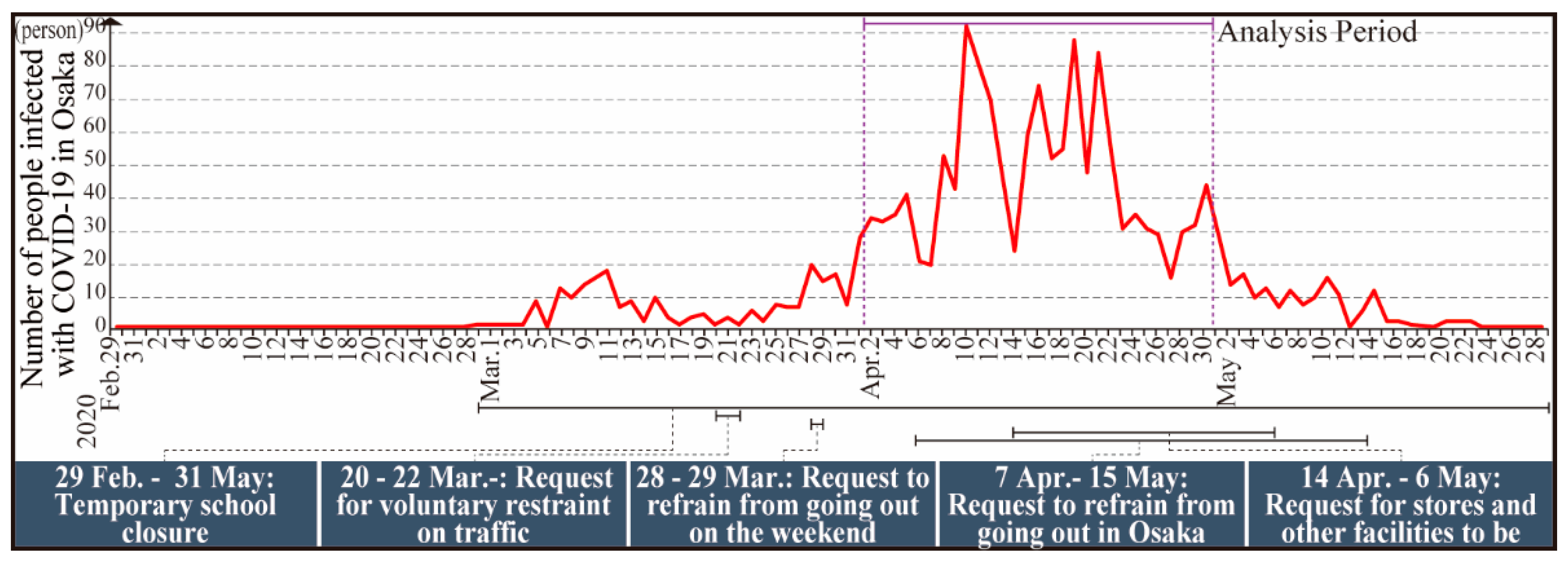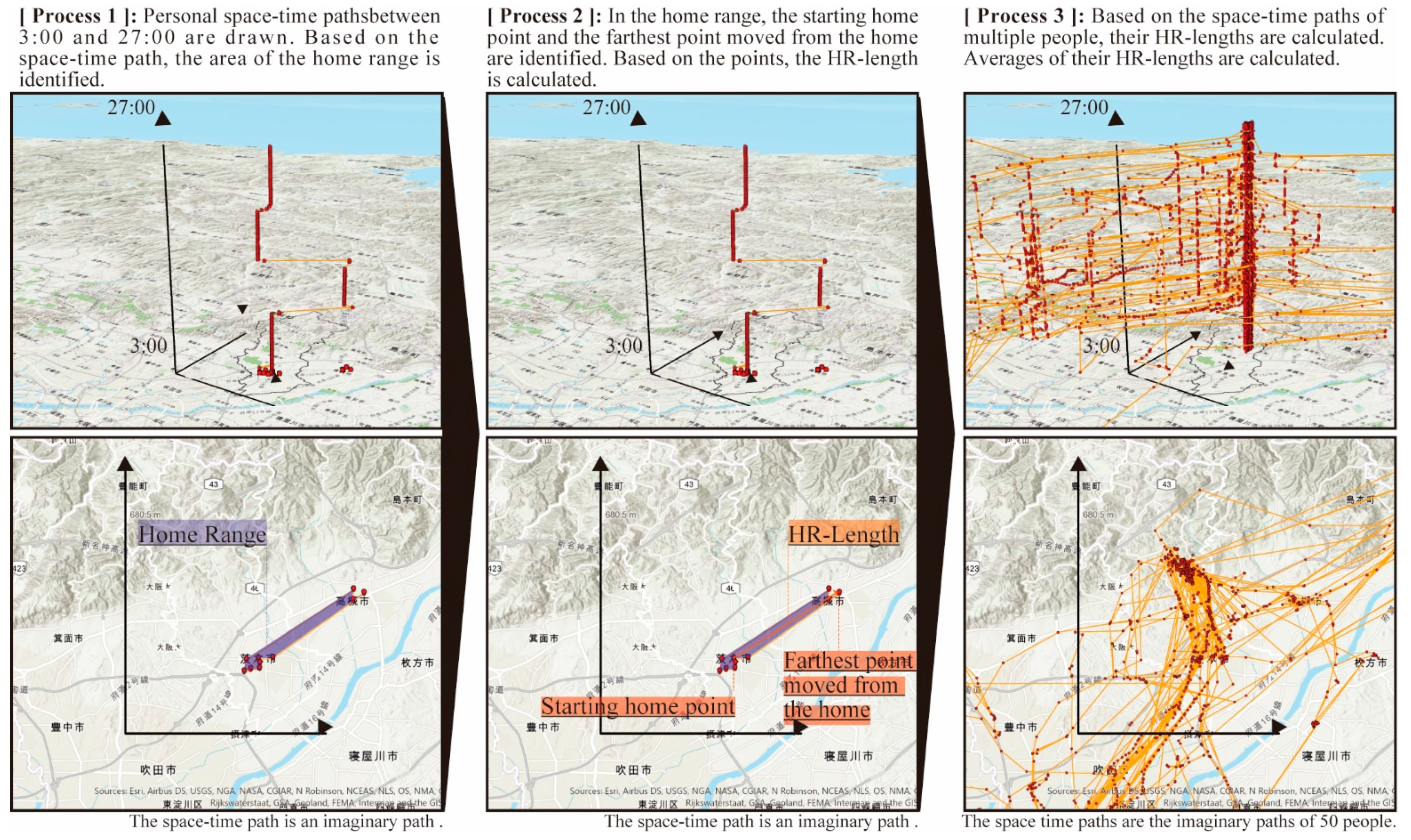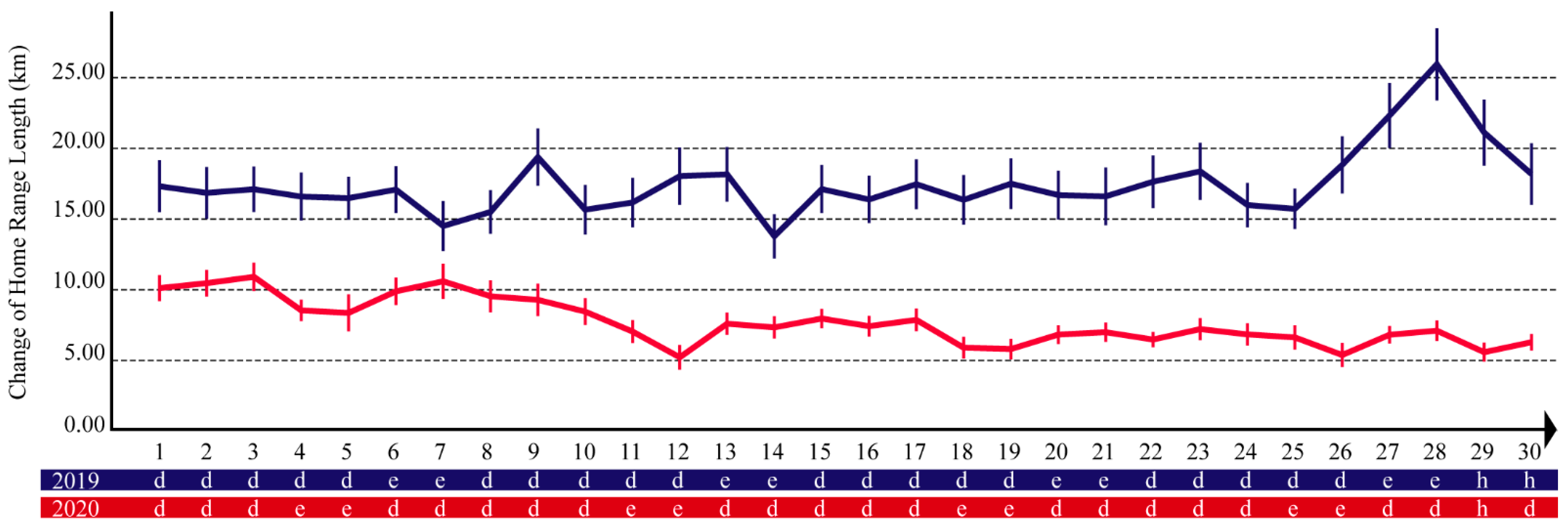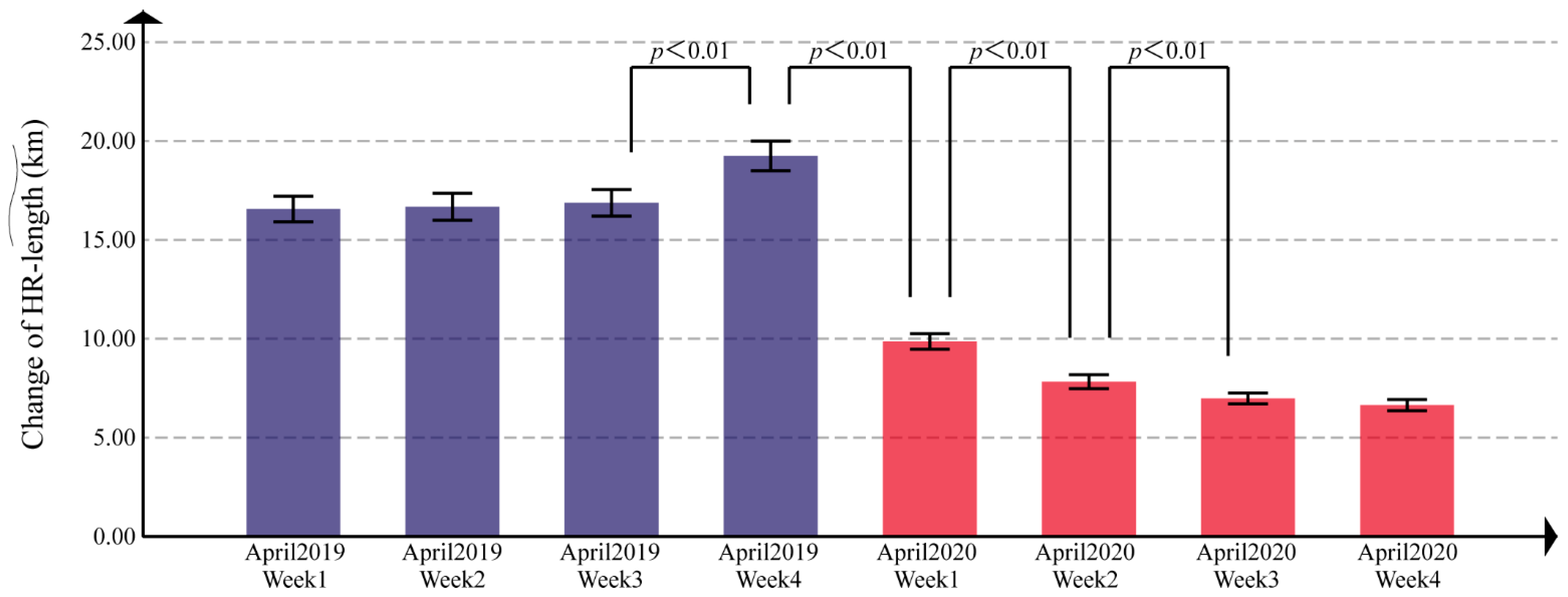Impact of COVID-19 Pandemic on Home Range in a Suburban City in the Osaka Metropolitan Area
Abstract
:1. Introduction
1.1. Background
1.2. Purpose
1.3. Novelty
2. Materials and Methods
2.1. Mobile Phone GPS Location History Data
2.2. Panel Data Analysis for the COVID-19 Pandemic
2.3. Minimum Convex Polygon
3. Results
3.1. Change of Daily Home Range Length
3.2. Change of Weekly Home Range Length
3.3. Municipalities of the Farthest Points
4. Discussion
5. Conclusions
Author Contributions
Funding
Institutional Review Board Statement
Informed Consent Statement
Data Availability Statement
Acknowledgments
Conflicts of Interest
References
- Statistics Bureau of Japan. Statistical Handbook of Japan 2020. Available online: https://www.stat.go.jp/english/data/handbook/c0117.html (accessed on 5 August 2021).
- Japanese MHLW (Ministry of Health, Labour, and Welfare). Establishing “the Community-Based Integrated Care System.”. Available online: https://www.mhlw.go.jp/english/policy/care-welfare/care-welfare-elderly/dl/establish_e.pdf (accessed on 30 June 2021).
- Burt, W.H. Territoriality and home range concepts as applied to mammals. J. Mammal. 1943, 24, 346–352. [Google Scholar] [CrossRef]
- Kato, H. How Does the Location of Urban Facilities Affect the Forecasted Population Change in the Osaka Metropolitan Fringe Area? Sustainability 2021, 13, 110. [Google Scholar] [CrossRef]
- Kato, H.; Kanki, K. Development of walkability indicator for visualising smart shrinking—A case study of sprawl areas in North Osaka Metropolitan Region. Int. Rev. Spat. Plan. Sustain. Dev. 2020, 8, 39–58. [Google Scholar] [CrossRef] [Green Version]
- Kato, H. Effect of Walkability on Urban Sustainability in the Osaka Metropolitan Fringe Area. Sustainability 2020, 12, 9248. [Google Scholar] [CrossRef]
- Cerin, E.; Saelens, B.E.; Sallis, J.F.; Frank, L.D. Neighborhood environment walkability scale: Validity and development of a short form. Med. Sci. Sports Exerc. 2006, 38, 1682–1691. [Google Scholar] [CrossRef] [Green Version]
- Inoue, S.; Murase, N.; Shimomitsu, T.; Ohya, Y.; Odagiri, Y.; Takamiya, T.; Ishii, K.; Katsumura, T.; Sallis, J.F. Association of physical activity and neighborhood environment among Japanese adults. Prev. Med. 2009, 48, 321–325. [Google Scholar] [CrossRef]
- Chen, B.-I.; Hsueh, M.-C.; Rutherford, R.; Park, J.-H.; Liao, Y. The associations between neighborhood walkability attributes and objectively measured physical activity in older adults. PLoS ONE 2019, 14, e0222268. [Google Scholar] [CrossRef]
- World Economic Forum. Paris Is Planning to Become a ‘15-minute City’. Available online: https://www.weforum.org/videos/paris-is-planning-to-become-a-15-minute-city-897c12513b (accessed on 2 April 2021).
- Balletto, G.; Ladu, M.; Milesi, A.; Borruso, G. A Methodological Approach on Disused Public Properties in the 15-Minute City Perspective. Sustainability 2021, 13, 593. [Google Scholar] [CrossRef]
- Prime Minister of Japan and His Cabinet. [COVID-19] Declaration of a state of emergency in response to the novel coronavirus disease. Kantei. 7 April 2020. Available online: https://japan.kantei.go.jp/ongoingtopics/_00018.html (accessed on 12 April 2021).
- Osaka Prefecture. COVID-19 Task Force website. Latest Updates on COVID-19 in Osaka. Available online: https://covid19-osaka.info/en (accessed on 13 June 2021).
- Kato, H. Development of a Spatio-temporal Analysis Method to Support the Prevention of COVID-19 Infection: Space-Time Kernel Density Estimation Using GPS Location History Data. In Urban Informatics and Future Cities; Geertman, S., Pettit, C., Goodspeed, R., Staffans, A., Eds.; Springer Nature: Cham, Switzerland, 2021; pp. 51–67. ISBN 978-3-030-76058-8. [Google Scholar] [CrossRef]
- Kato, H.; Matsushita, D. Changes in Walkable Streets during the COVID-19 Pandemic in a Suburban City in the Osaka Metropolitan Area. Sustainability 2021, 13, 7442. [Google Scholar] [CrossRef]
- Muto, K.; Yamamoto, I.; Nagasu, M.; Tanaka, M.; Wada, K. Japanese citizens’ behavioral changes and preparedness against COVID-19: An online survey during the early phase of the pandemic. PLoS ONE 2020, 15, e0234292. [Google Scholar] [CrossRef]
- Lee, Y.H.; Lee, J.S.; Baek, S.C.; Hong, W.H. Spatial Equity with Census Population Data vs. Floating Population Data: The Distribution of Earthquake Evacuation Shelters in Daegu, South Korea. Sustainability 2020, 12, 8046. [Google Scholar] [CrossRef]
- Oliver, N.; Lepri, B.; Sterly, H.; Lambiotte, R.; Deletaille, S.; De Nadai, M.; Letouzé, E.; Salah, A.A.; Benjamins, R.; Cattuto, C. Mobile phone data for informing public health actions across the COVID-19 pandemic life cycle. Sci. Adv. 2020, 6, eabc0764. [Google Scholar] [CrossRef]
- Jia, J.S.S.; Lu, X.; Yuan, Y.; Xu, G.; Jia, J.M.; Christakis, N.A. Population flow drives spatio-temporal distribution of COVID-19 in China. Nature 2020, 582, 389–394. [Google Scholar] [CrossRef]
- Badr, H.S.; Du, H.R.; Marshall, M.; Dong, E.S.; Squire, M.M.; Gardner, L.M. Association between mobility patterns and COVID-19 transmission in the USA: A mathematical modelling study. Lancet Infect. Dis. 2020, 20, 1247–1254. [Google Scholar] [CrossRef]
- Chang, S.; Pierson, E.; Koh, P.W.; Gerardin, J.; Redbird, B.; Grusky, D.; Leskovec, J. Mobility network models of COVID-19 explain inequities and inform reopening. Nature 2021, 589, 82-U54. [Google Scholar] [CrossRef] [PubMed]
- Lee, M.; Zhao, J.; Sun, Q.; Pan, Y.; Zhou, W.; Xiong, C.; Zhang, L. Human mobility trends during the early stage of the COVID-19 pandemic in the United States. PLoS ONE 2020, 15, e0241468. [Google Scholar] [CrossRef]
- The Japan Times. The Coronavirus and Japan’s Constitution. 14 April 2020. Available online: https://www.japantimes.co.jp/opinion/2020/04/14/commentary/japan-commentary/coronavirus-japans-constitution/ (accessed on 9 June 2021).
- Japanese Law Translation. Outline of the Act Partially Amending the Act on Special Measures against Novel Influenza, etc., and Other Relevant Acts. Available online: http://www.japaneselawtranslation.go.jp/common/data/outline/210621192151_905R207.pdf (accessed on 1 July 2021).
- Anzai, A.; Nishiura, H. “Go To Travel” Campaign and Travel-Associated Coronavirus Disease 2019 Cases: A Descriptive Analysis, July–August 2020. J. Clin. Med. 2021, 10, 398. [Google Scholar] [CrossRef] [PubMed]
- Yabe, T.; Tsubouchi, K.; Fujiwara, N.; Wada, T.; Sekimoto, Y.; Ukkusuri, S.V. Non-compulsory measures sufficiently reduced human mobility in Tokyo during the COVID-19 epidemic. Sci. Rep. 2020, 10, 18053. [Google Scholar] [CrossRef] [PubMed]
- Mizuno Laboratory. COVID-19 Special Site: Visualization of the Percentage of People Who Refrain from Going Out. National Institute of Informatics. Available online: http://research.nii.ac.jp/~mizuno/ (accessed on 9 April 2021).
- Agoop Corporation. Homepage. Available online: https://www.agoop.co.jp/en/ (accessed on 12 April 2021).
- Ministry of Health, Labour and Welfare (MHLW). Press: Ministry of Health, Labour and Welfare and Agoop Sign Agreement on Provision of Information Conducive to COVID-19 Cluster Response. Available online: https://www.mhlw.go.jp/stf/newpage_11116.html (accessed on 9 June 2021). (In Japanese)
- LBMA Japan. Guidelines for the Use of Device Location Data. Available online: https://www.lbmajapan.com/guideline (accessed on 12 April 2021). (In Japanese).
- Agoop. Application “WalkCoin.”. Available online: https://www.agoop.co.jp/appslib/walkcoin/ (accessed on 4 July 2021). (In Japanese).
- Ichinose, R.; Maruyama, Y.; Nagata, S. Estimation of the number of floating population based on location data collected from smartphones. J. Jpn. Soc. Civ. Eng. 2018, 74, I_210–I_219. [Google Scholar] [CrossRef]
- Osaka Prefecture Government. Outline of Emergency Measures of Osaka Prefecture. Available online: http://www.pref.osaka.lg.jp/attach/38687/00000000/0407_(EN)Emergency%20Measures%20of%20Osaka%20Prefecture.pdf (accessed on 12 April 2021).
- Osaka Prefecture Government. Request for Facility Use Restrictions. Available online: http://www.pref.osaka.lg.jp/attach/38687/00000000/Revised(EN)Facility%20Use%20Restrictions%20.pdf (accessed on 9 April 2021).
- Worton, B.J. Kernel Methods for Estimating the Utilization Distribution in Home-Range Studies. Ecology 1989, 70, 164–168. [Google Scholar] [CrossRef]
- Worton, B.J. Using Monte Carlo Simulation to Evaluate Kernel-Based Home Range Estimators. J. Wildl. Manag. 1995, 59, 794–800. [Google Scholar] [CrossRef]
- Anderson, D.J. The Home Range—A New Nonparametric-Estimation Technique. Ecology 1982, 63, 103–112. [Google Scholar] [CrossRef]
- Ibaraki City Government. Requests for Use of the Park in Conjunction with Measures to Prevent the Spread of COVID-19. 1 June 2020. Available online: https://www.city.ibaraki.osaka.jp/saigai/shingatacoronavirusinformation/oshirase/kouen/47738.html (accessed on 25 September 2020). (In Japanese).
- Doubleday, A.; Choe, Y.; Isaksen, T.B.; Miles, S.; Errett, N.A. How did outdoor biking and walking change during COVID-19?: A case study of three US cities. PLoS ONE 2021, 16, e0245514. [Google Scholar] [CrossRef]
- Osaka Prefectural Police. Location of Traffic Accidents in the Southern Part of Ibaraki City [Map of All Traffic Accidents]. Available online: https://www.police.pref.osaka.lg.jp/kotsu/jiko/3/1/10143.html (accessed on 5 April 2021). (In Japanese).
- Oishi, S.; Cha, Y.J.; Schimmack, U. The Social Ecology of COVID-19 Cases and Deaths in New York City: The Role of Walkability, Wealth, and Race. Soc. Psychol. Personal. Sci. 2021, 10, 1948550620979259. [Google Scholar] [CrossRef]
- Portland Plan. 20-minute Neighborhoods. Available online: https://www.portlandonline.com/portlandplan/index.cfm?a=288098&c=52256 (accessed on 5 April 2021).
- Project for Public Spaces. PLACEMAKING—What If We Built Our Cities around Places? Available online: https://www.pps.org/wp-content/uploads/2016/10/Oct-2016-placemaking-booklet.pdf (accessed on 4 July 2021).
- Project for Public Spaces. You Asked, We Answered: How Can Public Space Managers Help Fight COVID-19? Available online: https://www.pps.org/article/you-asked-we-answered-how-can-public-space-managers-help-fight-covid-19 (accessed on 4 July 2021).







Publisher’s Note: MDPI stays neutral with regard to jurisdictional claims in published maps and institutional affiliations. |
© 2021 by the authors. Licensee MDPI, Basel, Switzerland. This article is an open access article distributed under the terms and conditions of the Creative Commons Attribution (CC BY) license (https://creativecommons.org/licenses/by/4.0/).
Share and Cite
Kato, H.; Takizawa, A.; Matsushita, D. Impact of COVID-19 Pandemic on Home Range in a Suburban City in the Osaka Metropolitan Area. Sustainability 2021, 13, 8974. https://doi.org/10.3390/su13168974
Kato H, Takizawa A, Matsushita D. Impact of COVID-19 Pandemic on Home Range in a Suburban City in the Osaka Metropolitan Area. Sustainability. 2021; 13(16):8974. https://doi.org/10.3390/su13168974
Chicago/Turabian StyleKato, Haruka, Atsushi Takizawa, and Daisuke Matsushita. 2021. "Impact of COVID-19 Pandemic on Home Range in a Suburban City in the Osaka Metropolitan Area" Sustainability 13, no. 16: 8974. https://doi.org/10.3390/su13168974
APA StyleKato, H., Takizawa, A., & Matsushita, D. (2021). Impact of COVID-19 Pandemic on Home Range in a Suburban City in the Osaka Metropolitan Area. Sustainability, 13(16), 8974. https://doi.org/10.3390/su13168974






